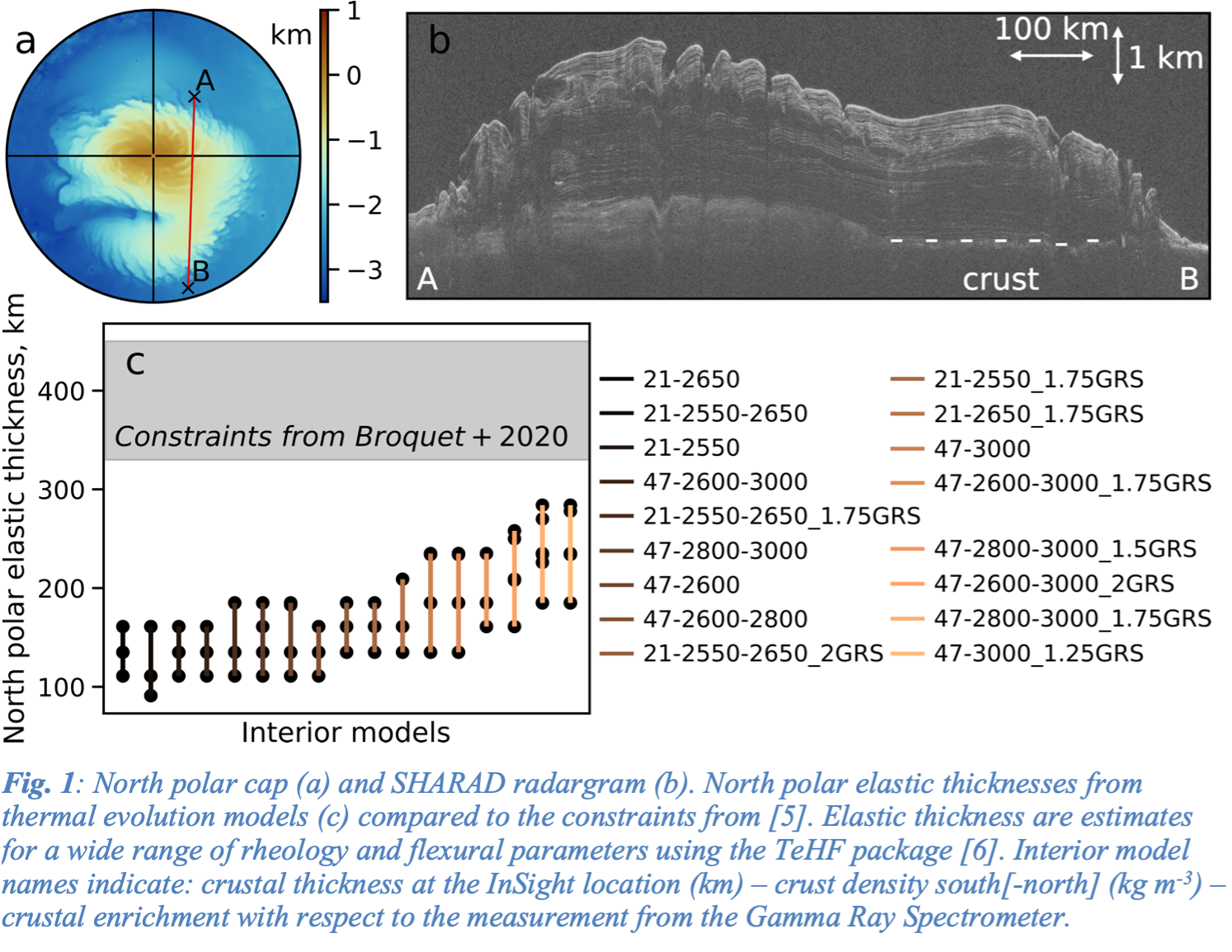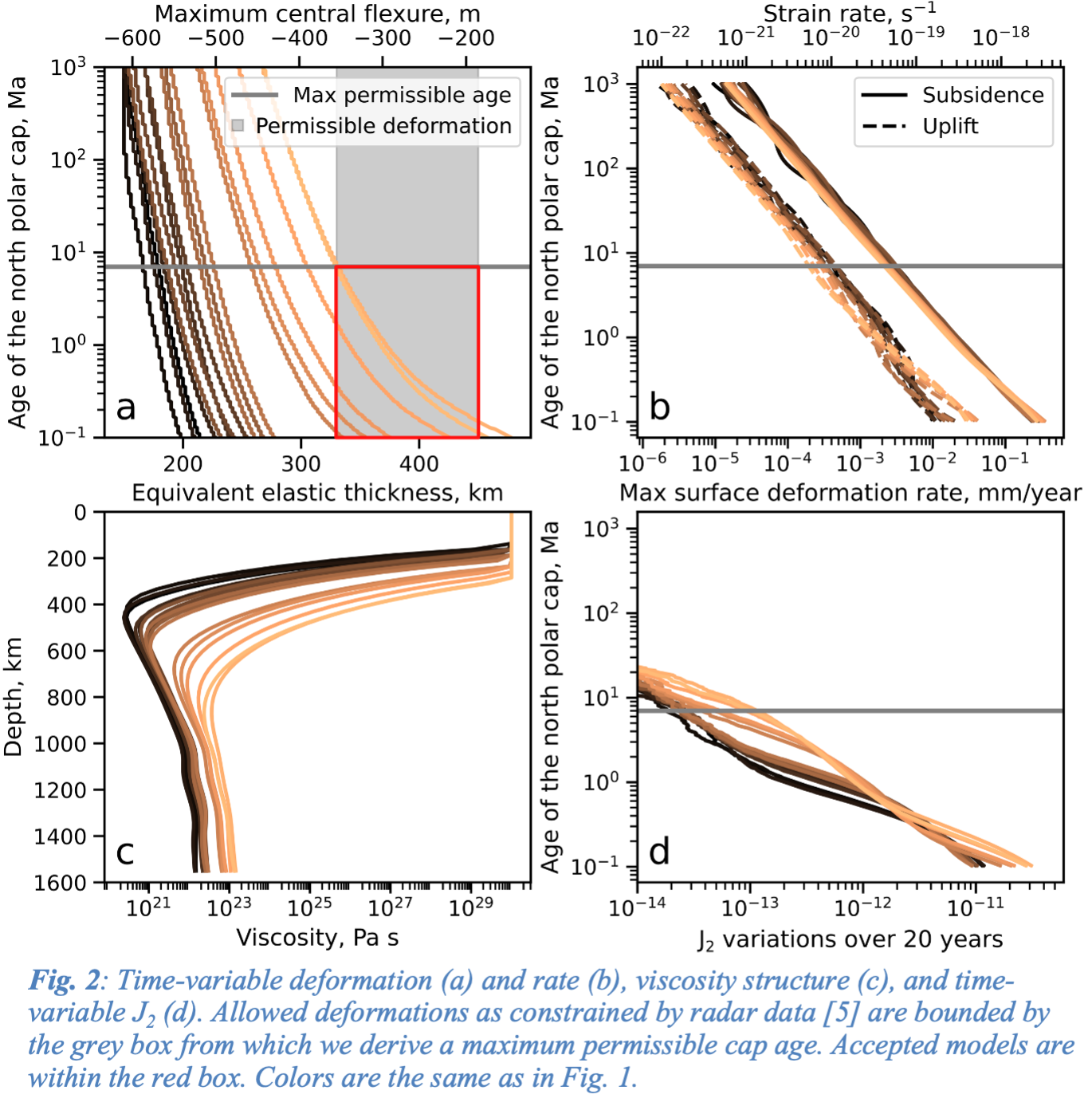Glacial isostatic adjustment on Mars
- 1German Aerospace Center (DLR), Department of Planetary Physics, Germany (adrien.broquet@dlr.de)
- 2Université Paris Cité, Institut de Physique du Globe de Paris, CNRS, Paris, France
- 3Delft University of Technology, Delft, the Netherlands
- 4German Research Centre for Geosciences, GFZ, Potsdam, Germany
- 5Sapienza University of Rome, Rome, Italy
- 6University of Arizona, Tucson, AZ, USA
Introduction: The response of a planet to loading is intimately linked to its interior structure. On Earth, studying the time-variable response of the lithosphere to the growth and decay of large ice sheets, or glacial isostatic adjustment (GIA), has been the standard approach to constrain the mantle structure [1]. However, such models have rarely been applied to the other terrestrial planets because of a lack of observational data [2].
Mars harbors two geologically young (<100 Ma) and large (~1000 km across) polar ice caps [3], which represent the only million-year-old surface features that can induce measurable surface deformations. Radar sounders have mapped these ice caps [4,5] and the lack of lithospheric flexure beneath the north polar cap (Fig. 1a,b) was used to constrain the interior of the planet to be cold with a stiff elastic lithosphere [4,5,7]. While the results of these studies are used to constrain the present-day thermal state of Mars [8], geodynamic models [9] struggle to explain the stiff lithosphere inferred at the north pole and, at the same time, young volcanism [10] and ongoing plume activity [11] (Fig. 1c).

Importantly, previous analyses have assumed the polar deformation to be at equilibrium, which is only valid if the time elapsed since the ice cap formed is greater than the time required for viscous adjustments. Previous calculations suggested that viscoelastic relaxation could allow thinner lithospheres and higher heat flows beneath the northern cap [4,5]. However, these estimations were based on simplistic constant mantle viscosity interiors, and only examined a single wavelength to represent the load, thereby providing limited insights into the potential effects of viscoelastic relaxation. Here, we investigate GIA on Mars in light of newly acquired InSight constraints on the planet’s interior structure [8–12]. Viscoelastic simulations of the polar deformations are coupled with thermal evolution models that account for InSight seismic measurements and observational constraints on recent volcanic activity [9–11].
Methods: We have run a large suite of 3-D thermal evolution models using interior structure parameters constrained by InSight [9]. We test crustal thickness models [12] and vary other key parameters such as the distribution of radioactive heat sources [13]. The occurrence of present-day melting in these simulations is used to select acceptable models. In total, 17 models with a wide range of crustal structures are selected (Fig. 1). None of these models match the results from [4,5], and in absence of external constraints, all these models are equally possible.
To explore the extent of relaxation beneath the north polar cap, Love numbers are computed using ALMA [14]. Therein, the momentum equation of an incompressible Maxwell viscoelastic planet is solved applying a propagator method. Love numbers are calculated up to Legendre degree 50, which is sufficient to resolve the polar cap loading (~degree 8, ~1250 km wavelength).
For each of the 17 models, the predicted internal structure beneath the northern cap (>60°N) is discretized into 68 constant-thickness layers with given viscosity, density, and rigidity, from the core to the surface (Fig. 2). The time evolution of the deformation for these models is predicted using ALMA and the polar cap load potential [5,7]. Our model assumes that the ice cap formed instantly at a given time in Martian history. We also estimate the rate of deformation and the associated time-variable degree-2 zonal gravity coefficient (J2). A model is deemed acceptable if the predicted viscoelastic deformation matches radar observations [5].

Results and conclusions: The present-day interior structure beneath the northern cap shows mantle viscosities ranging from 1021 to 1024 Pa s (Fig. 2). Given the large interior viscosity, the equilibrium response of the interior to loading is achieved over long-timescales (>100 Myr). The north polar cap is young (<10 Ma, [15]), which implies that GIA is presently occurring on Mars. As a result, the elastic lithosphere thickness estimated in [4,5] are overestimated. In particular, some geodynamic models that were deemed unsuccessful because of their mismatch to the north polar elastic thickness are now acceptable (Fig. 1-2).
Only a subset of models predicts small polar deformations consistent with radar observations [4,5], and these are characterized by a thick crust (≥50 km on average), cold lithosphere (elastic thickness >150 km), and large mantle viscosity (>1022 Pa s). A thick crust is consistent with the independent reassessment of InSight seismic data [16]. Models with a higher crustal heat production cool faster, have higher mantle viscosities, slower interior response to loading and thus better fit radar observations. For accepted models, GIA in the polar regions show rates >10-3 mm/year and strain rates >10-20 s-1.
Our analysis further constrains the bulk of the northern cap to have formed no more than 7 Myr ago, which is in remarkable agreement with independent Global Climate Model [15]. Models with a linear ice cap formation would imply even younger ages. If the mantle viscosity were precisely known, our framework could be used to place constraints on the formation history of the ice cap.
GIA affects the long-wavelength gravity field. Over the last 20 years, J2 may have varied by up to 10-11 m s-2. Together, our results implies that GIA could be measured from precise laser ranging or with a dedicated GRAIL-like gravity mission to Mars [17,18]. Alternatively, reanalyses and extended collection of radio tracking data could enable discerning a trend in the gravity field.
References: [1] Peltier W. R. (1974). [2] Greve R., et al. (2003) [3] Byrne S. (2009). [4] Phillips R. et al. (2008). [5] Broquet A. et al. (2020). [6] Broquet A. (2020) AB-Ares/Te_HF_Conversion [7] Broquet A. et al. (2021) JGR:Planets. [8] Khan A. et al. (2021). [9] Plesa A.-C. et al. (2022). [10] Voigt J. R. C. et al. (2023). [11] Broquet A. & Andrews-Hanna J. C. (2023). [12] Wieczorek M. A. et al. (2022). [13] Hahn B. C. et al. (2011). [14] Spada G. (2008). [15] Levrard B. et al. (2007). [16] Kim D. et al. (2023). [17] Genova A. (2020). [18] Wörner L. et al. (2023).
How to cite: Broquet, A., Plesa, A.-C., Breuer, D., Wieczorek, M. A., Root, B. C., Klemann, V., Genova, A., and Andrews-Hanna, J. C.: Glacial isostatic adjustment on Mars, Europlanet Science Congress 2024, Berlin, Germany, 8–13 Sep 2024, EPSC2024-847, https://doi.org/10.5194/epsc2024-847, 2024.